When you think about enhancing joint flexibility and movement, it's crucial to contemplate a range of authentic techniques that can make a significant difference. Dynamic stretching, mindful practices like yoga, and even foam rolling can all contribute to better mobility and overall performance. However, the effectiveness of these methods often hinges on how consistently you incorporate them into your routine. What specific strategies can you adopt to truly maximize your flexibility? Understanding the nuances of these practices could reveal new levels of movement potential for you.
Importance of Joint Flexibility
Joint flexibility plays an essential role in your overall physical health and mobility. When your joints are flexible, it allows for a greater range of motion, which can enhance your performance in physical activities. Whether you're running, dancing, or simply reaching for an item on a high shelf, flexible joints help you move with ease and efficiency.
Additionally, maintaining good joint flexibility can help prevent injuries. Tight joints increase the risk of strains and sprains, as they don't allow for the necessary movements during physical activities. By focusing on improving your flexibility, you're not just enhancing your athletic performance; you're also protecting your body from potential harm.
Moreover, joint flexibility contributes to better posture and alignment. When your joints are flexible, it's easier to maintain a balanced stance, which can reduce stress on your muscles and joints. This can considerably decrease discomfort and pain, especially in your back and neck.
Incorporating stretching routines into your daily life can be a game changer for your flexibility. Even simple stretches can greatly impact how your joints feel and function.
Dynamic Stretching Techniques
Regularly incorporating dynamic stretching techniques into your warm-up routine can greatly enhance your joint flexibility and overall performance. These techniques involve controlled movements that take your joints and muscles through their full range of motion, helping to prepare your body for physical activity.
Start with leg swings to loosen up your hips. Stand next to a wall or support, swing one leg forward and backward, gradually increasing the height of the swing. Switch legs after 10-15 swings.
Next, try arm circles. Extend your arms out to the sides and make small circles, gradually increasing the circle size. Do this for about 30 seconds, then reverse the direction.
Walking lunges are another effective technique. Step forward with your right leg into a lunge, keeping your knee over your ankle. Push off with your right foot and bring your left leg forward into the next lunge. Repeat this for 10-12 lunges on each side.
Incorporate high knees by jogging in place while bringing your knees up towards your chest. This not only warms up your hips but also engages your core.
Finally, consider torso twists. Stand with your feet shoulder-width apart and gently twist your upper body side to side, allowing your arms to follow the movement.
Benefits of Yoga
Incorporating yoga into your routine can greatly enhance your joint flexibility and overall well-being. As you practice yoga, you engage in a series of postures that stretch and strengthen your muscles, which helps improve your range of motion. This increased flexibility not only benefits your joints but also reduces the risk of injury in daily activities.
Yoga encourages mindfulness and body awareness, allowing you to connect with your body on a deeper level. As you focus on your breath and movements, you learn to listen to what your body needs, helping you avoid pushing yourself too hard and causing strain. This mindful approach fosters a healthy relationship with your body, promoting long-term physical and mental health.
Additionally, yoga often incorporates balance and stability challenges, which can further enhance joint strength. By practicing various poses, you train your body to stabilize and control movements, leading to better joint function over time. This can be especially beneficial as you age, helping you maintain mobility and independence.
Moreover, the calming effects of yoga can alleviate stress and tension, both physically and mentally. When you reduce stress, you're less likely to hold tension in your muscles, which can contribute to stiffness and discomfort in your joints. The relaxation techniques you learn in yoga can be powerful tools for managing stress in your everyday life.
Foam Rolling Benefits
Foam rolling serves as a powerful tool for enhancing muscle recovery and promoting joint flexibility. When you roll over tight muscles, you help release tension and break down knots, making it easier for your body to move freely.
By incorporating foam rolling into your routine, you can improve your overall flexibility, which is essential for joint health.
One of the main benefits you'll experience is increased blood flow. As you apply pressure to specific areas, you stimulate circulation, delivering essential nutrients to your muscles and aiding in recovery.
This increased blood flow not only helps your muscles heal faster but also prepares them for more intense workouts.
Foam rolling can also enhance your range of motion. By loosening tight fascia and connective tissues, you create more space for your joints to move.
This is particularly important if you engage in activities that require a high degree of flexibility, such as yoga or dance. You'll notice that your movements become smoother and more controlled, reducing the risk of injury.
Moreover, foam rolling can alleviate soreness post-exercise. By regularly incorporating this technique, you can prevent stiffness that often follows an intense workout, making it easier to stay active.
Proper Warm-Up Routines
A solid warm-up routine is essential for preparing your body for exercise and preventing injury. When you warm up, you increase blood flow to your muscles, raise your heart rate, and enhance your range of motion. To get started, spend about 5 to 10 minutes on dynamic movements that mimic the activities you'll be doing during your workout.
Begin with light aerobic exercises like jogging or jumping jacks to elevate your heart rate. Follow this with dynamic stretches, focusing on the major muscle groups you'll engage. For example, if you plan to run, incorporate leg swings, walking lunges, and high knees. These movements help activate your muscles and joints, making them more pliable.
It's important to target areas that may be particularly tight or prone to injury. If you have a history of knee or shoulder issues, pay extra attention to those joints during your warm-up. Include movements like arm circles or torso twists to promote flexibility and mobility in those areas.
Listen to your body during this process. If a particular movement feels uncomfortable or painful, modify it or skip it altogether. Your warm-up should feel invigorating, not exhausting. Aim to finish your routine feeling warm and ready to tackle your workout.
Incorporating Techniques Daily
To improve your joint flexibility, integrating daily stretching routines and mindful movement practices is key.
You can start by setting aside just a few minutes each day to focus on these techniques.
Consistency will help you feel the benefits and enhance your overall mobility.
Daily Stretching Routines
Incorporating daily stretching routines into your regimen can greatly enhance joint flexibility and overall mobility. When you commit to stretching every day, you'll notice improvements in your range of motion and decreased stiffness.
Start with a few minutes each morning or evening, focusing on key areas like your hips, shoulders, and back.
Begin with dynamic stretches to warm up your muscles. Simple movements like arm circles, leg swings, and torso twists can help.
Once you're warmed up, move into static stretches, holding each position for 15 to 30 seconds. Pay attention to your breath; inhaling deeply can help you relax into each stretch.
Be consistent and gradually increase the intensity of your stretches. If you find a specific area feels tight, spend a little more time there.
Consider incorporating stretching into other activities, like while watching TV or after exercising.
Listen to your body and avoid pushing too hard; you want to feel a gentle pull, not pain.
Keeping a stretching journal can help track your progress and motivate you to stick with your routine.
Mindful Movement Practices
Engaging in mindful movement practices can transform your approach to flexibility and overall well-being. By integrating techniques like yoga, tai chi, or qigong into your daily routine, you'll foster a deeper connection between your mind and body.
These practices encourage you to focus on your breath, align your movements, and cultivate awareness of your body's sensations. As you move, pay attention to how your joints feel. Notice areas of tightness and allow yourself to gently explore these sensations. This awareness can help you identify where you might need to stretch or strengthen.
Set aside time each day to practice, even if it's just for a few minutes. Incorporate mindful movement into your life by choosing a specific time, such as morning or evening. Use this time to engage in gentle stretches or flows, ensuring you breathe deeply and remain present.
Over time, you'll not only enhance your flexibility but also reduce stress and improve your mental clarity.
Conclusion
Incorporating authentic techniques like dynamic stretching, yoga, and foam rolling into your routine can greatly enhance your joint flexibility and movement. By committing to proper warm-up routines and practicing mindful movements daily, you'll not only improve your flexibility but also boost your overall physical performance. Remember, consistency is key! So, make these techniques a regular part of your life, and you'll feel the benefits in no time. Your body will thank you for it!



